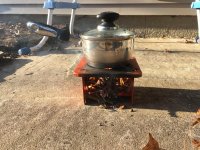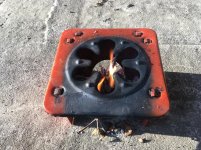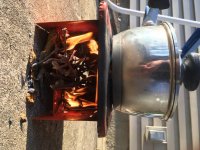That looks like a very nice stove. If you need more information/parts check with http://www.colemancollectorsforum.com. They like stoves of all makes.
-
Happy Publication of Dickens' "A Christmas Carol" (1843)! 😠👻🩼🎄
You are using an out of date browser. It may not display this or other websites correctly.
You should upgrade or use an alternative browser.
You should upgrade or use an alternative browser.
Stoves
- Thread starter TheIndian
- Start date
I guess I missed this thread. I was out tripping when it was going on.
I use twig and alcohol stoves almost exclusively. I cook over fire as much as I can and prefer the twig stove for that. It's a littlbug Jr. and I've been very happy with it. There is a short learning curve to burning with a twig stove. You can't let the flames burn down too far or else the new wood you add won't ignite. They don't tend to produce coals; you'll only be left with cold ashes.
They light fast and tend to burn hot. For boiling water they're dead easy. I cram the fire box pretty full with small sticks and twigs and when it starts to burn down just a little I'll start adding a few bigger ones. Doesn't take long at all to boil water for my solo uses.
I also cook a lot of bannock over my twig stove (usually daily) and pancakes as well. I want less heat for those so there are two options. Tending the pan more closely by holding it higher above the flame or taking it on/off to modulate temperature or else try to have a cooler flame.
To get a cooler flame I find it works best to burn larger chunks of wood, preferably split from larger round ('large' is relative when you're talking twig stoves). It hardly takes any time or effort to cut up a few wrist size pieces of wood, about 3-4" long, and then baton them with a knife into smaller pieces. After getting a hot fire started with smaller twigs (or really small splits if it's been raining) I start adding the larger pieces. Because of their size they tend to burn longer and slower and will even start to produce some coals. This makes it easier to keep the fire relatively low and add more pieces as needed without the constant flare/fade you get when only feeding the stove small twigs.
What I like so much about the wood stove is that you only need a small rock to cook on top of, which doesn't damage anything growing on the ground, and it's so darn fast. You can start cooking over it immediately and by the time you're done eating there's usually only a small pile of cold ashes left so you're not dumping pot after pot of water onto the coals to extinguish them.
Here I am cooking bannock over my littbug. Nearby I found a small piece of cast iron from a stove (old trading post site) and set the stove on top of it.
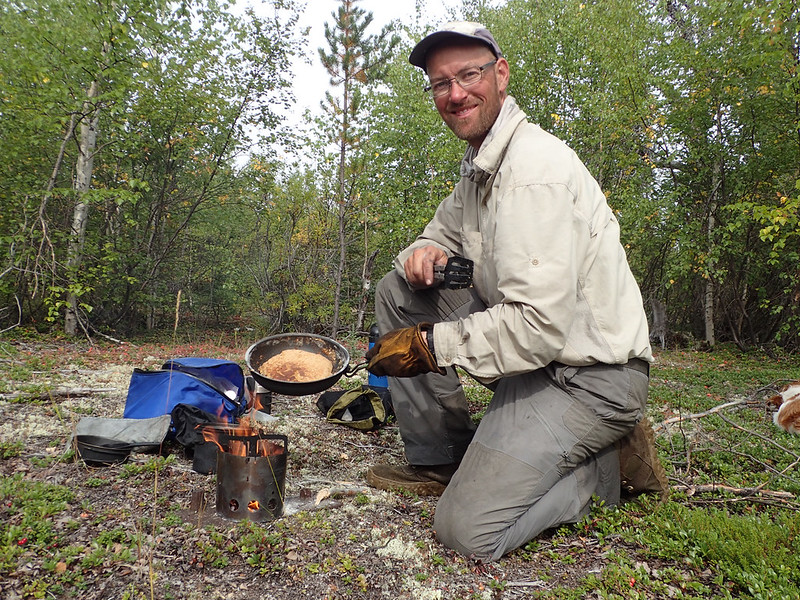 20160827_352 by Alan, on Flickr
20160827_352 by Alan, on Flickr
As for the alcohol stove I use a Trangia and it's my backup/lazy stove. I've never used another alcohol stove so can't do comparisons. I like that it has a lid so you don't have to empty the stove fuel after using it. I've never used the simmer ring except to snuff the flame; full output has worked fine for my needs. Since I don't expect to use it very often I don't bring along much fuel. My last trip was 42 days and I brought along 16 ounces of fuel. I didn't use the stove at all until day 28. The last couple weeks of the trip were nearly constant cold and rain so I got lazy and started using the stove and cooking in front of the tent opening so I could stay dry and relatively warm. I still had a few ounces of fuel left at the end of the trip.
To keep from carrying/buying extra equipment I use my littlbug Jr. as the wind screen and pot support. My pot is a snug fit but slips down inside my littlbug if I remove the pot supports. There are 4 rectangular holes in the littlbug a few inches down from the top. I put some short pieces of wire in those holes and this gives my pot something to sit on and puts it a little over an inch above the alcohol stove. Works out great.
When using the alcohol stove for my skillet I have a couple options, both of which involve putting the littlbug pot supports at their lowest position. I can either set the alcohol stove directly on the ground, which gives quite a distance between flame and pan (lower heat) or I can pile up a couple rocks or mound up dirt/sand to set the stove on. This brings it closer to the pan and heats it up more. I've cooked bannock and pancakes over the alcohol stove with no problem. It takes longer for the pan to warm up so it needs to be monitored. The first few pancakes take a while but by the end you need to be sure you don't burn them and take the skillet off the heat occasionally.
I don't know if it's the perfect system but it's worked out well for me so far. I would like to get a look at one of Bothwell's Nomad stoves.
 20160811_163 by Alan, on Flickr
20160811_163 by Alan, on Flickr
In this picture you can see some of the small splits I use for longer, cooler, and more consistent fires. In this case I'd worn through the stems of my canoe and needed to patch them mid-trip. It was overcast and drizzly so I used the stove to heat and dry the exposed wood before patching.
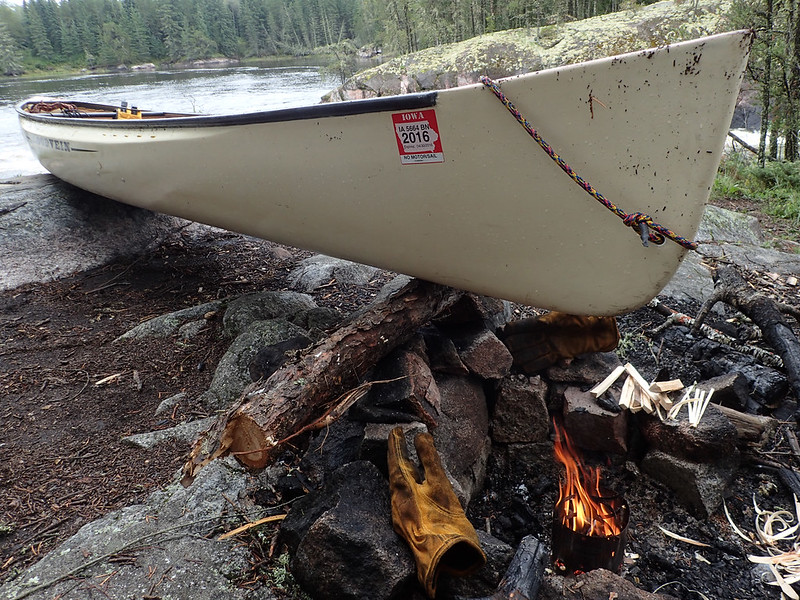 20150905_003 by Alan, on Flickr
20150905_003 by Alan, on Flickr
A few weeks ago I was in Arizona, mostly car camping, and brought along my old Coleman backpacking stove for roadside use. I hadn't used it for a few years and when I tried to fire it up found the gas valve was leaking. So while in Tucson I stopped and bought an MSR Whisperlight. I'm still leary of relying on multiple moving components for a long trip but it's a nice stove. Simple to use and easy to take apart. Throws out a lot of heat. I can see the appeal and I enjoyed using it; especially when a friend joined me for a few days and doubled the amount of food that needed to be cooked. It's too hot to cook oatmeal without burning (have to bring water to a boil and then add oatmeal) and needs a lot of attention when doing something like bannock but sure is nice for simply boiling water.
Alan
I use twig and alcohol stoves almost exclusively. I cook over fire as much as I can and prefer the twig stove for that. It's a littlbug Jr. and I've been very happy with it. There is a short learning curve to burning with a twig stove. You can't let the flames burn down too far or else the new wood you add won't ignite. They don't tend to produce coals; you'll only be left with cold ashes.
They light fast and tend to burn hot. For boiling water they're dead easy. I cram the fire box pretty full with small sticks and twigs and when it starts to burn down just a little I'll start adding a few bigger ones. Doesn't take long at all to boil water for my solo uses.
I also cook a lot of bannock over my twig stove (usually daily) and pancakes as well. I want less heat for those so there are two options. Tending the pan more closely by holding it higher above the flame or taking it on/off to modulate temperature or else try to have a cooler flame.
To get a cooler flame I find it works best to burn larger chunks of wood, preferably split from larger round ('large' is relative when you're talking twig stoves). It hardly takes any time or effort to cut up a few wrist size pieces of wood, about 3-4" long, and then baton them with a knife into smaller pieces. After getting a hot fire started with smaller twigs (or really small splits if it's been raining) I start adding the larger pieces. Because of their size they tend to burn longer and slower and will even start to produce some coals. This makes it easier to keep the fire relatively low and add more pieces as needed without the constant flare/fade you get when only feeding the stove small twigs.
What I like so much about the wood stove is that you only need a small rock to cook on top of, which doesn't damage anything growing on the ground, and it's so darn fast. You can start cooking over it immediately and by the time you're done eating there's usually only a small pile of cold ashes left so you're not dumping pot after pot of water onto the coals to extinguish them.
Here I am cooking bannock over my littbug. Nearby I found a small piece of cast iron from a stove (old trading post site) and set the stove on top of it.
 20160827_352 by Alan, on Flickr
20160827_352 by Alan, on FlickrAs for the alcohol stove I use a Trangia and it's my backup/lazy stove. I've never used another alcohol stove so can't do comparisons. I like that it has a lid so you don't have to empty the stove fuel after using it. I've never used the simmer ring except to snuff the flame; full output has worked fine for my needs. Since I don't expect to use it very often I don't bring along much fuel. My last trip was 42 days and I brought along 16 ounces of fuel. I didn't use the stove at all until day 28. The last couple weeks of the trip were nearly constant cold and rain so I got lazy and started using the stove and cooking in front of the tent opening so I could stay dry and relatively warm. I still had a few ounces of fuel left at the end of the trip.
To keep from carrying/buying extra equipment I use my littlbug Jr. as the wind screen and pot support. My pot is a snug fit but slips down inside my littlbug if I remove the pot supports. There are 4 rectangular holes in the littlbug a few inches down from the top. I put some short pieces of wire in those holes and this gives my pot something to sit on and puts it a little over an inch above the alcohol stove. Works out great.
When using the alcohol stove for my skillet I have a couple options, both of which involve putting the littlbug pot supports at their lowest position. I can either set the alcohol stove directly on the ground, which gives quite a distance between flame and pan (lower heat) or I can pile up a couple rocks or mound up dirt/sand to set the stove on. This brings it closer to the pan and heats it up more. I've cooked bannock and pancakes over the alcohol stove with no problem. It takes longer for the pan to warm up so it needs to be monitored. The first few pancakes take a while but by the end you need to be sure you don't burn them and take the skillet off the heat occasionally.
I don't know if it's the perfect system but it's worked out well for me so far. I would like to get a look at one of Bothwell's Nomad stoves.
 20160811_163 by Alan, on Flickr
20160811_163 by Alan, on FlickrIn this picture you can see some of the small splits I use for longer, cooler, and more consistent fires. In this case I'd worn through the stems of my canoe and needed to patch them mid-trip. It was overcast and drizzly so I used the stove to heat and dry the exposed wood before patching.
 20150905_003 by Alan, on Flickr
20150905_003 by Alan, on FlickrA few weeks ago I was in Arizona, mostly car camping, and brought along my old Coleman backpacking stove for roadside use. I hadn't used it for a few years and when I tried to fire it up found the gas valve was leaking. So while in Tucson I stopped and bought an MSR Whisperlight. I'm still leary of relying on multiple moving components for a long trip but it's a nice stove. Simple to use and easy to take apart. Throws out a lot of heat. I can see the appeal and I enjoyed using it; especially when a friend joined me for a few days and doubled the amount of food that needed to be cooked. It's too hot to cook oatmeal without burning (have to bring water to a boil and then add oatmeal) and needs a lot of attention when doing something like bannock but sure is nice for simply boiling water.
Alan
- Joined
- Jun 30, 2014
- Messages
- 1,550
- Reaction score
- 572
Alan, the Nomad stoves are quite easy to use. We have two, a regular sized one with a second raised floor position to use a trangia with it...the stove then acts as a windgard... and my older oversized one. The small one is one of Bothwells. What I like about them is the floor plate, so you can cook on the ground, and the front opening so you can feed them.
With my limitations now, only being able to do short trips, I just take a gas/propane stove since it is easier for me. Perhaps I will try primitive camping at some point where the twigs stove might be handy. On a long trip like you do, it would be ideal. I do love my colemans though.
With my limitations now, only being able to do short trips, I just take a gas/propane stove since it is easier for me. Perhaps I will try primitive camping at some point where the twigs stove might be handy. On a long trip like you do, it would be ideal. I do love my colemans though.
- Joined
- Jun 22, 2016
- Messages
- 163
- Reaction score
- 24
Thanks Alan.
Twig stove looks simple and easy to use but did you ever have an issue finding dry fuel for it?
I think they a great idea but like you mentioned the last days of your trip were kind of wet. Would you have been in a bind if you didn't have the Trangia?
Twig stove looks simple and easy to use but did you ever have an issue finding dry fuel for it?
I think they a great idea but like you mentioned the last days of your trip were kind of wet. Would you have been in a bind if you didn't have the Trangia?
Last edited:
Thanks Alan.
Twig stove looks simple and easy to use but did you ever have an issue finding dry fuel for it?
I think they a great idea but like you mentioned the last days of your trip were kind of wet. Would you have been in a bind if you didn't have the Trangia?
Finding dry fuel to burn was never an issue, just slightly more work. Even if I didn't have the Trangia I would have been fine. I'd already started lots of fires in the rain but it got to the point I was sick and tired of it and by that stage of the trip I wasn't worried about running out of fuel. Of course it's super easy when the weather is dry and all the dead twigs ignite easily. If it's raining, or has been raining, and all the little stuff is wet then it's no different than starting a big fire in the rain: you've got to get to the dry wood. Which means cutting larger pieces of wood and splitting them to access the dry wood inside. With a twig stove this is a lot easier because you need a a lot less wood and only short pieces.
It's very fast and easy to split those short wrist size or smaller pieces of wood into burnable chunks of multiple sizes. For this size I think batoning with a knife is faster, easier, and safer than using an axe or hatchet. I make sizes ranging from match stick to 3/4". I also make plenty of shavings from a longer piece of wood for kindling. Light the shavings and then start adding the split pieces, starting with the match sticks. Nothing to it. When you're done cooking remove the twig stove from the fire and start adding larger pieces of wood for a real fire.
The first day of my trip I got hit with rain and struggled to start my first fires in the dampness. After I got into the rhythm it got easier but after everything dried out I filled an empty zip-lock with birch bark and old man's beard and carried that in my food barrel so I'd have a ready supply of dry tinder just in case I needed to start a fire fast. Any time I broke into that stash for convenience sake I'd refill it when things dried out again. I also got into the habit of keeping some dry tinder and a handful to small twigs under the fly of my shelter, and off the ground, at night so they wouldn't be wet with dew or rain.
I also started carrying a supply of small, split, pieces of wood in my food barrel during the last 1 1/2 weeks of the trip. At this point my large barrel was completely empty and my small barrel was getting there too so a little extra weight from the wood was trivial (probably a little over a pound). The weather and water were both getting quite cold and I didn't have much hope things would change. A capsize would have been pretty serious and I wanted to be sure I could get at least a small fire established quickly to which I could start adding some larger pieces of damp wood.
Good news about twig stoves in wet weather is that those dead twigs dry out very quickly when exposed to the sun and wind. What was wet in the morning will probably be dry and crunchy by evening if the weather improves.
Alan
"The first day of my trip I got hit with rain and struggled to start my first fires in the dampness. After I got into the rhythm it got easier but after everything dried out I filled an empty zip-lock with birch bark and old man's beard and carried that in my food barrel so I'd have a ready supply of dry tinder just in case I needed to start a fire fast. Any time I broke into that stash for convenience sake I'd refill it when things dried out again. I also got into the habit of keeping some dry tinder and a handful to small twigs under the fly of my shelter, and off the ground, at night so they wouldn't be wet with dew or rain."
Excellent advice Mr. Gage.
Amazing how 5 minutes of preparing for wet can make such a difference. I have been doing this for so long that it is second nature for me. Old Eagle Scout here.
Here in Louisiana, wet is relative. Just rain or flood? Dry tinder is always part of my trip inventory. And preparing for the next day by securing a fuel supply, under cover, and off of wet ground, sure makes that first cup of coffee easier to attain.
Excellent advice Mr. Gage.
Amazing how 5 minutes of preparing for wet can make such a difference. I have been doing this for so long that it is second nature for me. Old Eagle Scout here.
Here in Louisiana, wet is relative. Just rain or flood? Dry tinder is always part of my trip inventory. And preparing for the next day by securing a fuel supply, under cover, and off of wet ground, sure makes that first cup of coffee easier to attain.
Last edited:
Most of the time you can cook with the stuff in front of the fire pit. We did a lay over day and that second day we had to collect wood for our stove, most of that was collected where someone chopped down a tree.
- Joined
- Mar 20, 2013
- Messages
- 3,356
- Reaction score
- 972
We rarely bring a stove other the our fire box on trips, and never have a problem with finding dry wood! That said, if you travel on the coast of Alaska that can be an other story!!
Alan, we have a garbage bag full of birch bark out in the boathouse. Usually also use wood from a beaver lodge as it has dried for a long time.
- Joined
- Jun 22, 2016
- Messages
- 163
- Reaction score
- 24
No Title
Was lucky to get outta work early today and decided to test out a twig stove. Used an old sterno stove that was probly the first camping stove I ever bought. Conditions were perfect in the yard today...sunny, dry twigs and a slight breeze. I was able to get a pot of water to a rolling boil. Not sure if I would ever rely on one though. If the fuel was wet or if there was too much wind or if I fell asleep, the water would likely never boil. The stove great as it folds up nice and flat but I have to say I would like my coffee a little faster in the morning The real nuisance was having to always attend to the fire. Perhaps my "firebox" too small but I would imagine any twig stove requires lots of attention. Gonna stick with my Whisperlight for now. Here's a few pics...
The real nuisance was having to always attend to the fire. Perhaps my "firebox" too small but I would imagine any twig stove requires lots of attention. Gonna stick with my Whisperlight for now. Here's a few pics...
Was lucky to get outta work early today and decided to test out a twig stove. Used an old sterno stove that was probly the first camping stove I ever bought. Conditions were perfect in the yard today...sunny, dry twigs and a slight breeze. I was able to get a pot of water to a rolling boil. Not sure if I would ever rely on one though. If the fuel was wet or if there was too much wind or if I fell asleep, the water would likely never boil. The stove great as it folds up nice and flat but I have to say I would like my coffee a little faster in the morning
Attachments
Last edited:
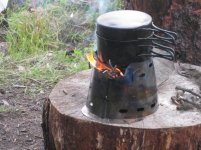
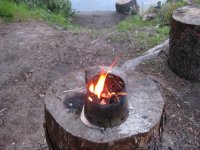 I've been a long time advocate for my Whisperlight International. Fantastic little stove that's worked at -30, high 90s (F), sea level & on top of a few tall mountains. In 20+ years it gave me trouble once, on the bank of the Yukon River. 20 minutes of fiddling & it was back to work. That being said, a couple of years ago I started sneaking back into backpacking & all of a sudden weight was a huge factor! Picked up a Ti-Tri and absolutely love it! It will burn nesbit or alcohol when I'm feeling lazy, (or it's not too cold), but the thing that sold me was the wood. Creates a really hot fire in no time, burns pretty much anything I can fit into it, leaves you with nothing other than a handful of white ash when it's done. Hoping for a solo trip in the Yukon this summer & they'll both come along, the whisperlight if it's really wet or cold, the Ti-Tri for most of the cooking. I'm looking to bring everclear for fuel, but I might find another use for it on a cold windy day! Nothing cheap about it, but good equipment rarely is. Even comes with a 2 piece titanium plate to go under it that protects the ground or stump it's sitting on.
I've been a long time advocate for my Whisperlight International. Fantastic little stove that's worked at -30, high 90s (F), sea level & on top of a few tall mountains. In 20+ years it gave me trouble once, on the bank of the Yukon River. 20 minutes of fiddling & it was back to work. That being said, a couple of years ago I started sneaking back into backpacking & all of a sudden weight was a huge factor! Picked up a Ti-Tri and absolutely love it! It will burn nesbit or alcohol when I'm feeling lazy, (or it's not too cold), but the thing that sold me was the wood. Creates a really hot fire in no time, burns pretty much anything I can fit into it, leaves you with nothing other than a handful of white ash when it's done. Hoping for a solo trip in the Yukon this summer & they'll both come along, the whisperlight if it's really wet or cold, the Ti-Tri for most of the cooking. I'm looking to bring everclear for fuel, but I might find another use for it on a cold windy day! Nothing cheap about it, but good equipment rarely is. Even comes with a 2 piece titanium plate to go under it that protects the ground or stump it's sitting on.The Rocket Stove: https://www.youtube.com/watch?v=2lynzQ_MGho
I've been playing around with twig stoves recently and decided to see how much wood I would use to boil a liter of water. I gathered dry branches half an inch in diameter and under, mostly Apple and Maple and broke them into 3 inch pieces. I had over a pound of twigs and my plan was to build a fire and keep feeding it until my pot of water came to a full boil and then weigh the twigs left over. The wind was probably around fifteen miles per hour when I went looking for a sheltered place to set the stove up. It is virtually impossible to find a place that is calm around here. The wind is forecast to be 15 to 25 MPH for the next week. I got the fire started and put the pot on. I then proceeded to feed twigs to the fire for the next fifty minutes. I had a good fire most of that time, but ran out of twigs and never did get the water to boil. I blame most of this on the wind and I'm looking for a tall windscreen(10 to 12" tall) to use with this stove. My experience with windscreens on stoves in this kind of wind has not been good. The wind seems to shift directions and gusts all the time. It usually blows my wind screen over. I still want to boil some water and I'll try different fuels, split branches, pellets as well as twigs. I've got three Lixada (Chinese) twig stoves and I'm trying to use the lightest one, which is made like three nesting cans, a support, the firebox and a chimney with a fuel feed hole. The flames from the fire are pretty soft compared to canister stoves and the wind is a huge factor. Alcohol stoves have soft flames, but they are usually short and easier to shield from the wind. I don't see much point in carrying one of these if I can't use fuel that I find in the woods or have to spend a lot of time preparing the fuel.
Here you can see the wind screen I made a long time ago fro my Svea stove, just hardware store hobby aluminum. I comes 4"X12" I used four panels, just drilled some holes and joined with split rings. Not too heavy and it folds up flat. I now have some 22 gauge titanium so I'm thinking of remaking it more in size with the twig stove. It took this little stove about 20 minutes to boil a quart of water.
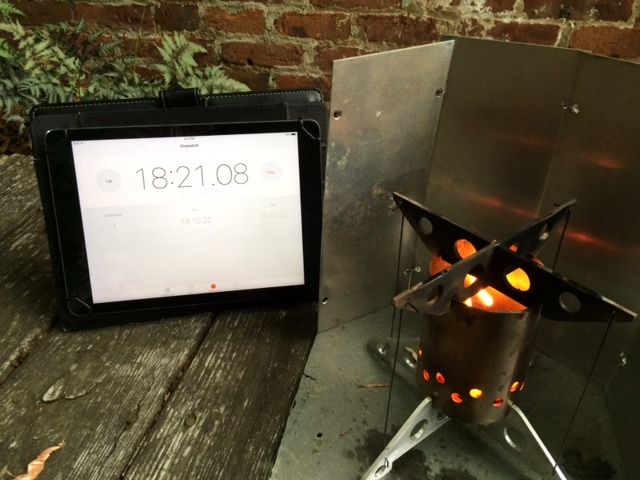
On another note that Colman Peak one multi fuel stove I mentioned much further upthread works like a champ. I tried it out a couple of weeks ago.
Jim

On another note that Colman Peak one multi fuel stove I mentioned much further upthread works like a champ. I tried it out a couple of weeks ago.
Jim
I've never used a wind screen with my twig stove but I do try to find a sheltered place to set it up if it's windy. I can usually get 16 ounces of water boiling in 5 minutes. Keep plenty of wood in the firebox. Don't let it die down and then feed it. As soon as there's room drop some more in. Use larger pieces once it's fully established but keep adding some small ones too to keep it burning fast and hot.
I like being able to feed wood from the top. It's too hard trying to slide it in from the side. Just lift the pot off with a gloved hand and stand the pieces up vertically.
I've got a new twig stove and a 4 year old to play with this weekend. I'll see what kind of trouble we can get into with it.
Alan
I like being able to feed wood from the top. It's too hard trying to slide it in from the side. Just lift the pot off with a gloved hand and stand the pieces up vertically.
I've got a new twig stove and a 4 year old to play with this weekend. I'll see what kind of trouble we can get into with it.
Alan
I can't recall how long the Ti-Tri took to boil water but I would definitely remember if I'd been unhappy. It most certainly wasn't 50 minutes, or 20. 5 sounds about right, but I never really timed it. For sure the Whisperlight is faster, but it doesn't smell as good, warm my hands the same, or give me the sense of satisfaction that burning scraps & pine-cones from my campsite does. I have maybe a dozen stoves, these two cover all my needs for backpacking, ski camping with a pulk & canoeing, and my old green 2 burner Coleman takes care of any "tailgate" or car camping needs that might arise. Mind you, with exchange, duty & shipping I have nearly $300 invested in the Ti-Tri plus matching titanium pot. That could have bought a lot of gear, even a decent used canoe.
I haven't given up on my twig stoves and I've got some 0.050" aluminum that I can use to make a wind screen, I just haven't gotten around to it.
I was feeding twigs every few seconds and had a good looking fire all along, it just wouldn't boil my water. Lixada markets a huge variety of twig stoves and some of them may actually work. They are all stainless steel and cheap, also fun to play around with. I used a different one last week to make lunch and it was fine. I still want to see if I can get this one to work. It's light and fits nicely into my Billy Pot.
I was feeding twigs every few seconds and had a good looking fire all along, it just wouldn't boil my water. Lixada markets a huge variety of twig stoves and some of them may actually work. They are all stainless steel and cheap, also fun to play around with. I used a different one last week to make lunch and it was fine. I still want to see if I can get this one to work. It's light and fits nicely into my Billy Pot.
Last edited:
I uploaded a couple of stock photos of this stove to an album linked to my profile. The first one is sorta what this stove looks like in the wind. I don't use the two little pot supports, but set my pot directly on top of the chimney.
I have a Kelly Kettle Scout...41 oz size
Once I get the fire going (depending on recent rainfall or not, 1 to 4 minutes) it boils a nearly full pot in less than 2 minutes!!
Windy?? All the better, rotate the base so the draft hole faces the wind and look out!! Sounds like a train coming.
View attachment r3tXzwn4th0w9KEtIo3nVSX5RzgQSD8knnhY4YWNj-Q1Dfx9wIRa5aAReBblPcQabJtF0xw5o_aa8w3dxjK3IHmgbWtb4B_8kcPW
Once I get the fire going (depending on recent rainfall or not, 1 to 4 minutes) it boils a nearly full pot in less than 2 minutes!!
Windy?? All the better, rotate the base so the draft hole faces the wind and look out!! Sounds like a train coming.
View attachment r3tXzwn4th0w9KEtIo3nVSX5RzgQSD8knnhY4YWNj-Q1Dfx9wIRa5aAReBblPcQabJtF0xw5o_aa8w3dxjK3IHmgbWtb4B_8kcPW
Similar threads
- Replies
- 58
- Views
- 11K
- Replies
- 23
- Views
- 5K
- Replies
- 8
- Views
- 2K

